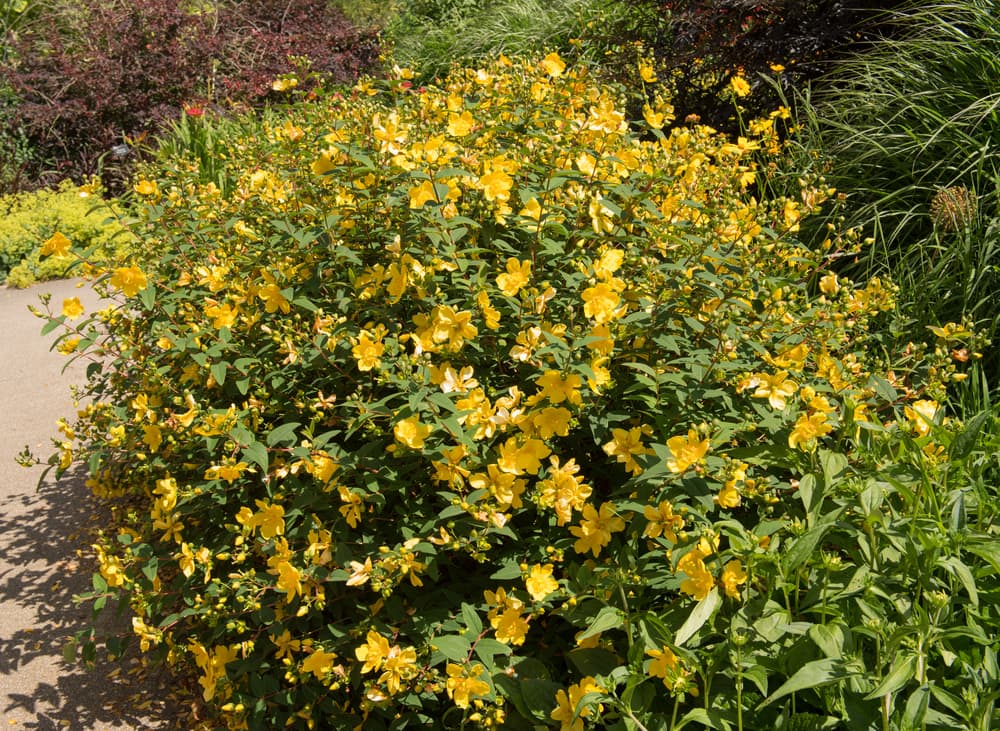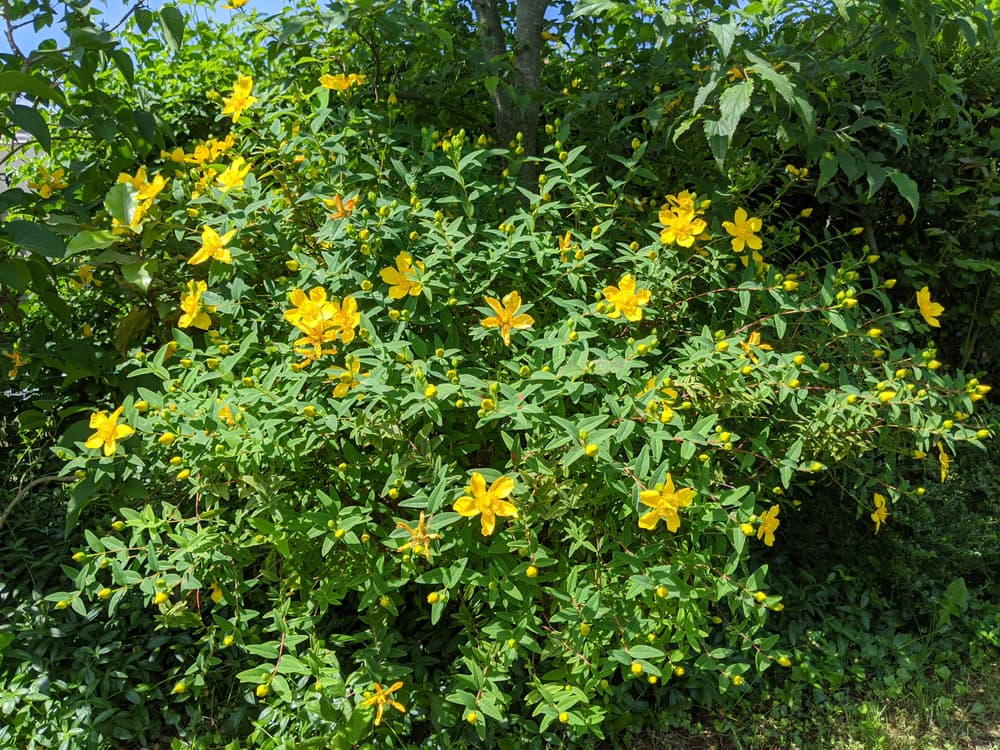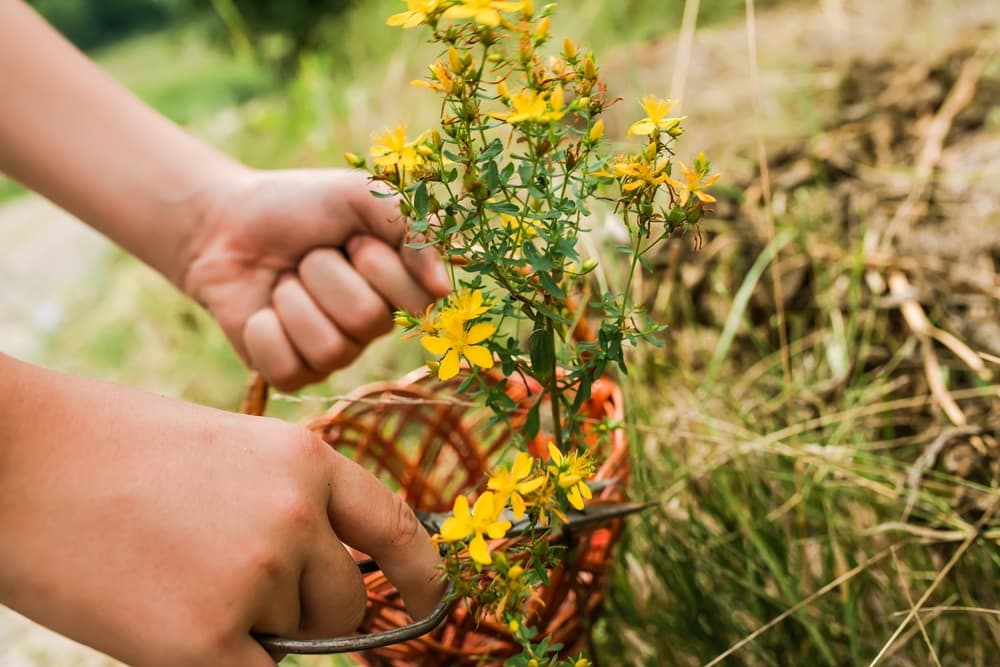PERENNIALS > HYPERICUM
Reviewed By PETER LICKORISH

Peter is a Horticulture Lecturer and self-employed Horticulturist, with a passion for diverse areas of the industry - from garden design to the science behind plant growth and propagation. He has completed the Royal Horticultural Society’s Master of Horticulture (MHort) Award and lectures on RHS courses at Bedford College.
IN THIS GUIDE
HYPERICUM GUIDES
St. John’s Wort is a herbaceous perennial showcasing paired green leaves and attractive, star-shaped flowers in various shades of yellow, that will brighten up even the dreariest of gardens.
It is a plant that grows easily in the UK climate and can thrive in all soil types.
You should, however, air on the side of caution if you plan to add it to your garden, as in many local areas it is classified as a noxious weed.1Common St. Johnswort identification and control: Hypericum perforatum. (2018, September 18). King County. Retrieved March 20, 2023, from https://kingcounty.gov/services/environment/animals-and-plants/noxious-weeds/weed-identification/st-johns-wort.aspx
If that doesn’t put you off, and you’re still keen to bring St. John’s Wort into your garden, read on for our best care and growing tips, to find out everything you need to know about this bright and widespread wonder plant.
Overview
| Botanical Name | Hypericum perforatum |
| Common Name(s) | St John’s Wort |
| Plant Type | Perennial Flower |
| Native Area | Europe, North Africa, South-West Asia |
| Hardiness Rating | H6 |
| Foliage | Small, ovate leaves, deciduous |
| Flowers | Star-shaped yellow flowers |
| When To Sow | March, April |
| Flowering Months | June, July, August |
| When To Prune | March |
Sunlight
Preferred
Full Sun / Partial Shade
Exposure
Exposed or Sheltered
Size
Height
0.5 – 1M
Spread
0.1 – 0.5M
Bloom Time
June – August
Soil
Preferred
Most Soil Types
Moisture
Moist but well drained
pH
Any
Hypericum ‘St John’s Wort’ is a member of the Hypericaceae family, and is found in most parts of the world, including Europe, North and South America, Australia and Asia.2Hanson, S. (2013, January 9). Hypericaceae – St John’s wort family. Whiteknights Biodiversity. Retrieved March 20, 2023, from https://blogs.reading.ac.uk/whiteknightsbiodiversity/2013/01/09/hypericaceae-st-johns-wort-family/
Due to its widespread nature, it is difficult to pin down exactly where it originated.
According to Kew, the variation Hypericum perforatum is thought to come from Europe, North Africa and Asia.3Hypericum perforatum. (n.d.). Kew Royal Botanic Gardens. Retrieved March 20, 2023, from https://powo.science.kew.org/taxon/urn:lsid:ipni.org:names:433719-1
There are thought to be around 400 different varieties of Hypericum, but it’s H. perforatum that is known as common St. John’s Wort.4Hypericum perforatum. (n.d.-b). North Carolina Extension Gardener Plant Toolbox. Retrieved March 20, 2023, from https://plants.ces.ncsu.edu/plants/hypericum-perforatum/

Other names for this popular variety include ‘Herb John’, ‘Devil Chaser’, ‘Devil’s Flight’ and ‘God’s Wonder Plant’.
It is also sometimes called ‘St. Columba’s Flower’.
When fully grown, H. perforatum reaches 0.5-1m in height, and a spread of up to 0.5m (it can take up to 5 years to reach this point).
It has reddish, woody stems and yellow-green leaves with translucent dots that make the leaves appear perforated and inspire its name.
In early summer, it produces bright yellow, star-shaped blooms of up to 2.5cm in diameter.
Habitat & Growing Conditions
Hypericum ‘St John’s Wort’ is thought to be native to Europe and Asia, but has spread and now grows in many other parts of the world, including North and South America, Australia and New Zealand.
It can thrive in a variety of climates, including those with summer or winter-dominant rainfall.

It generally grows in fields and pastures.
How To Grow St. John’s Wort
The best time to plant Hypericum ‘St. John’s Wort’ is in mid-spring, March to April, or in the autumn, in September or October.
However, you can plant at any time of the year, providing the soil is not frozen.
One of the best (and most common varieties) of St. John’s Wort to grow in the UK is H. x hidcoteense ‘Hidcote’.

This variety produces numerous bright yellow flowers throughout July and August and remains mostly evergreen over the winter.
It typically grows to 1.2m tall, and can also make an attractive hedging plant.
Planting
To plant a Hypericum, you should find a partially shaded spot in your garden and dig a hole double the size of the plant’s root ball.
Add the plant, along with some organic fertiliser, and re-fill the hole with soil – water the ground thoroughly.
Container Growing
St. John’s Wort will adapt to most growing conditions, and it is possible to grow it in a container – although this does not represent its ideal environment.
Make sure your container has good drainage, and keep the soil moist.
Hypericum Care
St. John’s Wort is a very hardy plant that is easy to grow in the UK and requires next to no maintenance once established.

It can thrive in sunny or shaded conditions, sheltered or exposed – the ideal spot for it is probably one with partial shade.
Soil
It will grow in most soil types, including clay, chalk and sandy, and all pHs, as long as the soil is moist and has good drainage.
The plant is therefore a perfect choice for any area of the garden and makes a particularly great addition to a riverbank, border or wildflower area.
You should plant your Hypericum in spring or autumn (providing the ground isn’t frozen), and water well.
Watering & Feeding
Once established, Hypericum requires very little ongoing care, but you should water as required during the growing period, or in cases of extreme drought.

You can also add a fertiliser twice a year for the first 5 years, to help it establish.
Propagation
Hypericum can be propagated by seed, division, or by taking softwood cuttings.
By Seed
To propagate by seed, sow seeds any time from mid-spring to early autumn.
Make sure the bed is well-dug and weed-free, and the surface soil is crumbly in texture.
Space the seeds around 0.5m apart, depending on the variety.
Keep the soil moist during the growing period.
By Division
To propagate Hypericum by division, you should act in spring or autumn, when the plant isn’t in active growth.

Lift the existing plant gently out of the ground, and divide the root ball into two.
Re-plant the divisions immediately, and water well.
This is an easy way of propagating Hypericum.
By Softwood Cuttings
If you want to take softwood cuttings, the best time to do this is in July and August, when the plant is in full bloom.
To take your cuttings, you should look for new growth and non-flowering shoots that will root more easily.
Take 10cm cuttings, starting from just above a bud.
Once you have your cutting, remove lower leaves and dip the bottom in a rooting hormone.

Plant your cuttings in a pot with compost and water them, then cover with a plastic bag and place them somewhere warm.
Keep the soil moist, and after around 10 weeks, your cuttings should be rooted and ready to pot individually.
References
- 1Common St. Johnswort identification and control: Hypericum perforatum. (2018, September 18). King County. Retrieved March 20, 2023, from https://kingcounty.gov/services/environment/animals-and-plants/noxious-weeds/weed-identification/st-johns-wort.aspx
- 2Hanson, S. (2013, January 9). Hypericaceae – St John’s wort family. Whiteknights Biodiversity. Retrieved March 20, 2023, from https://blogs.reading.ac.uk/whiteknightsbiodiversity/2013/01/09/hypericaceae-st-johns-wort-family/
- 3Hypericum perforatum. (n.d.). Kew Royal Botanic Gardens. Retrieved March 20, 2023, from https://powo.science.kew.org/taxon/urn:lsid:ipni.org:names:433719-1
- 4Hypericum perforatum. (n.d.-b). North Carolina Extension Gardener Plant Toolbox. Retrieved March 20, 2023, from https://plants.ces.ncsu.edu/plants/hypericum-perforatum/


